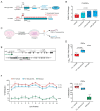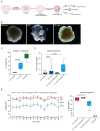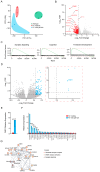Ascorbic Acid Ameliorates Molecular and Developmental Defects in Human-Induced Pluripotent Stem Cell and Cerebral Organoid Models of Fragile X Syndrome
- PMID: 39684429
- PMCID: PMC11641479
- DOI: 10.3390/ijms252312718
Ascorbic Acid Ameliorates Molecular and Developmental Defects in Human-Induced Pluripotent Stem Cell and Cerebral Organoid Models of Fragile X Syndrome
Abstract
Fragile X Syndrome (FX) is the most common form of inherited cognitive impairment and falls under the broader category of Autism Spectrum Disorders (ASD). FX is caused by a CGG trinucleotide repeat expansion in the non-coding region of the X-linked Fragile X Messenger Ribonucleoprotein 1 (FMR1) gene, leading to its hypermethylation and epigenetic silencing. Animal models of FX rely on the deletion of the Fmr1 gene, which fails to replicate the epigenetic silencing mechanism of the FMR1 gene observed in human patients. Human stem cells carrying FX repeat expansions have provided a better understanding of the basis of epigenetic silencing of FMR1. Previous studies have found that 5-Azacytidine (5Azac) can reverse this methylation; however, 5Azac can be toxic, which may limit its therapeutic potential. Here, we show that the dietary factor Ascorbic Acid (AsA) can reduce DNA methylation in the FMR1 locus and lead to an increase in FMR1 gene expression in FX iPSCs and cerebral organoids. In addition, AsA treatment rescued neuronal gene expression and morphological defects observed in FX iPSC-derived cerebral organoids. Hence, we demonstrate that the dietary co-factor AsA can partially revert the molecular and morphological defects seen in human FX models in vitro. Our findings have implications for the development of novel therapies for FX in the future.
Keywords: Ascorbic Acid; Autism Spectrum Disorders (ASD); FMR1; Fragile X Syndrome; cerebral organoids; gene silencing; induced pluripotent stem cells; methylation; neurodevelopmental disorders.
Conflict of interest statement
The authors declare no conflicts of interest.
Figures



Similar articles
-
Epigenetic characterization of the FMR1 gene and aberrant neurodevelopment in human induced pluripotent stem cell models of fragile X syndrome.PLoS One. 2011;6(10):e26203. doi: 10.1371/journal.pone.0026203. Epub 2011 Oct 12. PLoS One. 2011. PMID: 22022567 Free PMC article.
-
CGG-repeat dynamics and FMR1 gene silencing in fragile X syndrome stem cells and stem cell-derived neurons.Mol Autism. 2016 Oct 6;7:42. doi: 10.1186/s13229-016-0105-9. eCollection 2016. Mol Autism. 2016. PMID: 27713816 Free PMC article.
-
CGG Repeat-Induced FMR1 Silencing Depends on the Expansion Size in Human iPSCs and Neurons Carrying Unmethylated Full Mutations.Stem Cell Reports. 2016 Dec 13;7(6):1059-1071. doi: 10.1016/j.stemcr.2016.10.004. Epub 2016 Nov 10. Stem Cell Reports. 2016. PMID: 27840045 Free PMC article.
-
Epigenetics of fragile X syndrome and fragile X-related disorders.Dev Med Child Neurol. 2019 Feb;61(2):121-127. doi: 10.1111/dmcn.13985. Epub 2018 Aug 7. Dev Med Child Neurol. 2019. PMID: 30084485 Review.
-
Human pluripotent stem cell models of Fragile X syndrome.Mol Cell Neurosci. 2016 Jun;73:43-51. doi: 10.1016/j.mcn.2015.11.011. Epub 2015 Nov 27. Mol Cell Neurosci. 2016. PMID: 26640241 Free PMC article. Review.
Cited by
-
Orchestrating Nutrient Homeostasis: RNA-Binding Proteins as Molecular Conductors in Metabolic Disease Pathogenesis.Nutrients. 2025 Jul 19;17(14):2367. doi: 10.3390/nu17142367. Nutrients. 2025. PMID: 40732992 Free PMC article. Review.
-
Therapeutic strategies for fragile X syndrome and implications for other gene-silencing disorders.Nat Genet. 2025 Aug;57(8):1812-1822. doi: 10.1038/s41588-025-02255-6. Epub 2025 Jul 17. Nat Genet. 2025. PMID: 40676228 Review.
References
-
- Verkerk A.J., Pieretti M., Sutcliffe J.S., Fu Y.H., Kuhl D.P., Pizzuti A., Reiner O., Richards S., Victoria M.F., Zhang F.P., et al. Identification of a gene (FMR-1) containing a CGG repeat coincident with a breakpoint cluster region exhibiting length variation in fragile X syndrome. Cell. 1991;65:905–914. doi: 10.1016/0092-8674(91)90397-H. - DOI - PubMed
MeSH terms
Substances
Grants and funding
LinkOut - more resources
Full Text Sources
Medical

